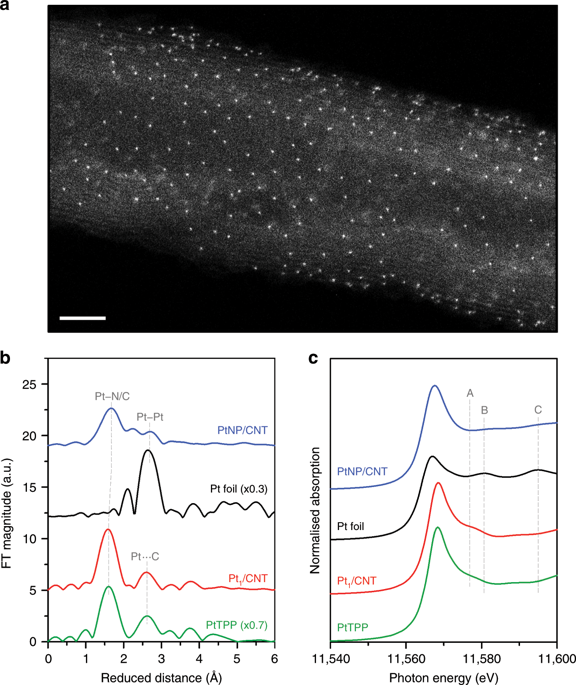当前位置:
X-MOL 学术
›
Nat. Commun.
›
论文详情
Our official English website, www.x-mol.net, welcomes your
feedback! (Note: you will need to create a separate account there.)
Atomically dispersed Pt-N4 sites as efficient and selective electrocatalysts for the chlorine evolution reaction.
Nature Communications ( IF 14.7 ) Pub Date : 2020-01-21 , DOI: 10.1038/s41467-019-14272-1 Taejung Lim 1 , Gwan Yeong Jung 1 , Jae Hyung Kim 1 , Sung O Park 1 , Jaehyun Park 1 , Yong-Tae Kim 2 , Seok Ju Kang 1 , Hu Young Jeong 3 , Sang Kyu Kwak 1 , Sang Hoon Joo 1
Nature Communications ( IF 14.7 ) Pub Date : 2020-01-21 , DOI: 10.1038/s41467-019-14272-1 Taejung Lim 1 , Gwan Yeong Jung 1 , Jae Hyung Kim 1 , Sung O Park 1 , Jaehyun Park 1 , Yong-Tae Kim 2 , Seok Ju Kang 1 , Hu Young Jeong 3 , Sang Kyu Kwak 1 , Sang Hoon Joo 1
Affiliation

|
Chlorine evolution reaction (CER) is a critical anode reaction in chlor-alkali electrolysis. Although precious metal-based mixed metal oxides (MMOs) have been widely used as CER catalysts, they suffer from the concomitant generation of oxygen during the CER. Herein, we demonstrate that atomically dispersed Pt-N4 sites doped on a carbon nanotube (Pt1/CNT) can catalyse the CER with excellent activity and selectivity. The Pt1/CNT catalyst shows superior CER activity to a Pt nanoparticle-based catalyst and a commercial Ru/Ir-based MMO catalyst. Notably, Pt1/CNT exhibits near 100% CER selectivity even in acidic media, with low Cl- concentrations (0.1 M), as well as in neutral media, whereas the MMO catalyst shows substantially lower CER selectivity. In situ electrochemical X-ray absorption spectroscopy reveals the direct adsorption of Cl- on Pt-N4 sites during the CER. Density functional theory calculations suggest the PtN4C12 site as the most plausible active site structure for the CER.
中文翻译:

原子分散的 Pt-N4 位点作为氯析出反应的高效和选择性电催化剂。
析氯反应(CER)是氯碱电解中的关键阳极反应。尽管贵金属基混合金属氧化物(MMO)已被广泛用作 CER 催化剂,但它们在 CER 过程中会同时产生氧气。在此,我们证明了掺杂在碳纳米管(Pt1/CNT)上的原子分散的 Pt-N4 位点可以催化 CER,具有优异的活性和选择性。 Pt1/CNT 催化剂表现出优于 Pt 纳米粒子基催化剂和商用 Ru/Ir 基 MMO 催化剂的 CER 活性。值得注意的是,即使在低 Cl 浓度 (0.1 M) 的酸性介质以及中性介质中,Pt1/CNT 也表现出接近 100% 的 CER 选择性,而 MMO 催化剂则表现出明显较低的 CER 选择性。原位电化学 X 射线吸收光谱揭示了 CER 过程中 Cl- 直接吸附在 Pt-N4 位点上。密度泛函理论计算表明 PtN4C12 位点是 CER 最合理的活性位点结构。
更新日期:2020-01-22
中文翻译:

原子分散的 Pt-N4 位点作为氯析出反应的高效和选择性电催化剂。
析氯反应(CER)是氯碱电解中的关键阳极反应。尽管贵金属基混合金属氧化物(MMO)已被广泛用作 CER 催化剂,但它们在 CER 过程中会同时产生氧气。在此,我们证明了掺杂在碳纳米管(Pt1/CNT)上的原子分散的 Pt-N4 位点可以催化 CER,具有优异的活性和选择性。 Pt1/CNT 催化剂表现出优于 Pt 纳米粒子基催化剂和商用 Ru/Ir 基 MMO 催化剂的 CER 活性。值得注意的是,即使在低 Cl 浓度 (0.1 M) 的酸性介质以及中性介质中,Pt1/CNT 也表现出接近 100% 的 CER 选择性,而 MMO 催化剂则表现出明显较低的 CER 选择性。原位电化学 X 射线吸收光谱揭示了 CER 过程中 Cl- 直接吸附在 Pt-N4 位点上。密度泛函理论计算表明 PtN4C12 位点是 CER 最合理的活性位点结构。











































 京公网安备 11010802027423号
京公网安备 11010802027423号